Musicians on the Menu
Swan Lake and swan-song to the series
Page created on 11 Jan 2012 and under construction. It is being used to test the viability of graphics.
The header graphic cannot be copied.
On the right is Pic 1 with caption integrated.
Here are previous articles in the series.
| Garnishes on Stage | |
| Martial Mentions on the Menu | |
| Martial Milestones on the Menu | |
| Monarchs on the Menu | |
| The Royal Table not published and referred to in the articles. | |
| More Monarchs on the Menu | |
| Mandarins on the Menu | |
| Middlemen on the Menu | |
|
See a magazine and Middlemen in the flesh. Click here for a copy of 'Food & Wine' September 2011 and find p 26 | |

So far, this is the text. The plan is to publish "Moscovites on the Menu" before this article. Tchaikovsky, however, was not included in the Répertoire de la Cuisine. The article will make amends.
Musicians on the Menu:
Swan Lake and swan-song to the series
by Prof Alan F Harrison
As we begin with Verdi, this is where we came in. In “Garnishes on the Stage” back in December 2009 p 16, he was first on the menu. Verdi was followed by Rossini, Meyerbeer, and Smetana, Sullivan ended that story and began the subsequent one in March 2010. Updating 2009, our first musician again is even more remembered on the menu with Tournedo Verdi. The beef fillet is dressed on foie gras, covered with Soubise (onion puree) and served with Duchesse potatoes (December 2010 p 23) filled with small balls of carrot and accompanied with braised lettuce. Filets de sole Verdi are cooked on a bed of diced macaroni, lobster and truffle. They are served with Sauce Mornay. (Mandarins on the Menu, June 2011, p 23.
Rossini needs his own article beyond the Tournedo Rossini (again with foie gras) referred to in December 2009. Boiling fowl are also adorned with the pâte and truffles before being hermetically cooked in the oven. Salade Rossini comprises lettuce, celery, chicory leaf and root, cress, and escarole endive. If the humble sole were the theme, it has the most garnishes devoted to it. In Filets de sole Rossini, they are rolled and covered with a sole farce augmented with foie gras before poaching. Presented in a circle, its centre is filled with a truffle ragoût. White wine sauce goes over the fillets. Oeuf Rossini is a fried egg on a bed of foie gras and sliced truffle. Sauce Périgueux accompanies and it is made from demiglace or rich brown sauce with truffle essence and chopped truffles. Omelette Rossini is quite similar regarding the ingredients. The Purée Rossini soup is chicken based and, again, is similar.
My first Food & Wine article was about “the three Ms” in June 2009 p 12 and covered three variations of the term “molecular” applied to food. In the present context, the three Ms are Mozart, Manon and Meyerbeer. Faisan Mozart is pheasant en casserole finished with cognac and served with French fried potato and artichoke-bottoms filled with celery purée.
Paupiette de sole Manon is when the fillets are rolled and poached. A round dish has been decorated with piped Duchesse potato mix and browned under the grill. The paupiettes are placed within the circle and covered with white wine sauce flavoured with fines herbes (the collective for chopped parsley, chives, tarragon and chervil). The centre of the circle is filled with asparagus tips and truffle strips (julienne). Oeuf sur le plat Meyerbeer is where the egg is in the dish previously buttered and seasoned, After baking, it is garnished with lamb-liver and served with Sauce Périgueux.
When Moscovites on the Menu has been finished, it is apparent that Tchaikovsky has not been remembered on the menu within the Répertoire de la Cuisine. He sits on the same music shelf as Verdi and Rossini, at least. He composed a whole ballet revolving around dancing candy and a prince enchanted to crack nuts between his wooden teeth. Let us remember him more gastronomically with Cygnes Tchaikovsky. Find someone who can make and shape meringue or choux pastry. Create necks, wings and bodies. Cut the tops from the bodies and fill them with poached fruit flavoured with a Russian liqueur. You are not limited to the standard approach of using vodka which loses its flavour in food. Try Slavyanskaya, for example. Make wings from the body-tops cut in half. Attach the necks and float your swans on a lake of jelly surrounded by dessicated coconut coloured green for the grass.
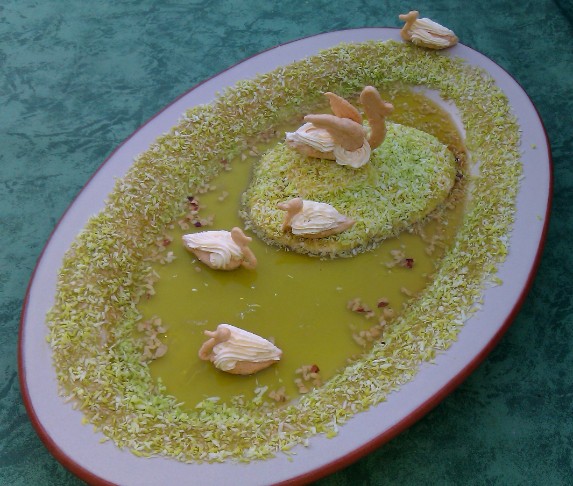
Pic 2
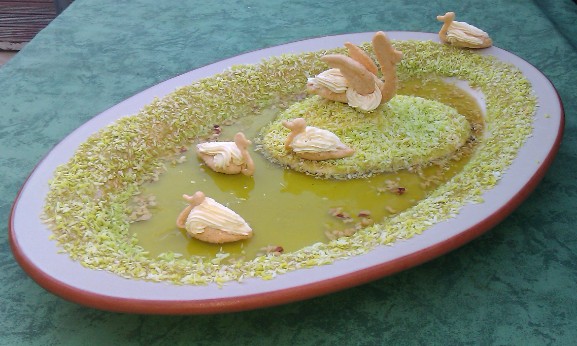
Pic 3
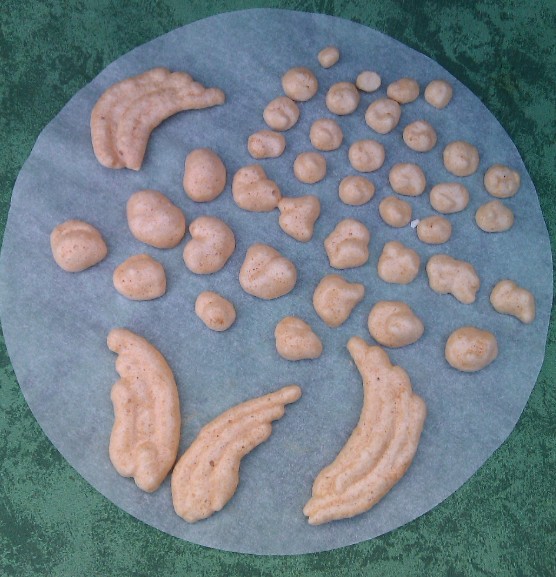
Pic 4 Wings for large swan. Rocks and mushroom tops did not work.
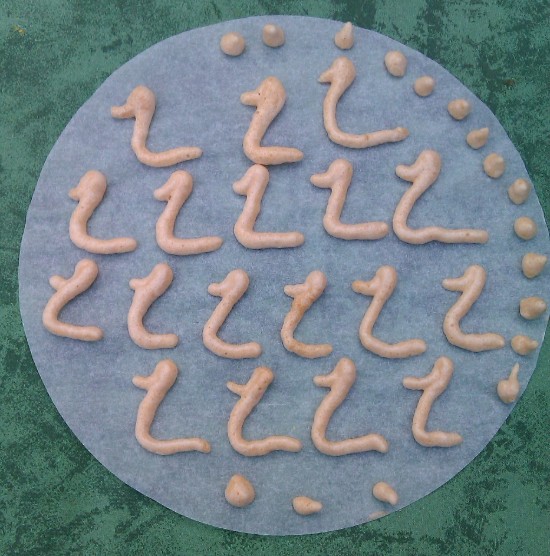
Pic 5 Use a cone of greaseproof paper to hold the meringue. Cut off the tip to give the correct diameter or bore. Use ready-made cake
bottom non-stick paper. The "mushroom stalks" would have been used with the tops in Pic 4, but they did not work. Better to use
choux paste which makes eclairs.
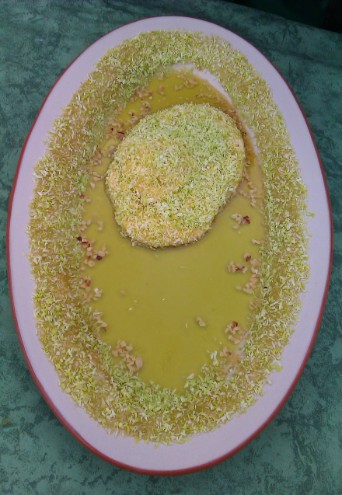
Pic 6 The dish was floated with pineapple jelly. It is difficult to find the right colour. Blue looks as if it is sea. Green is also not right.
The island is a meringue "dollop" flattened to the right size. Grass is dessicated coconut coloured green and stuck in place with
boiled jam on the end of a pastry brush. The stones of chopped nuts should be in place before the jelly sets.
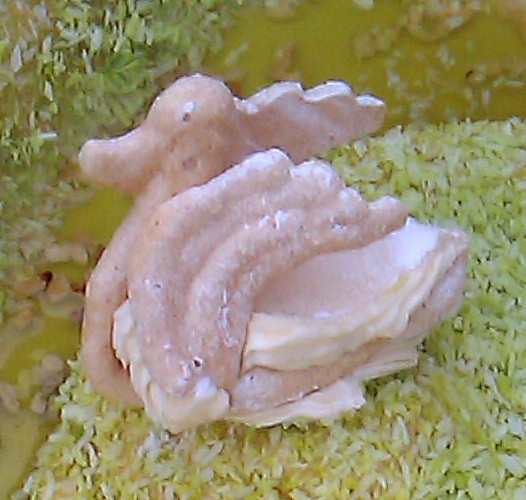
Pic 7 Unused swan but not looking sorry for itself.
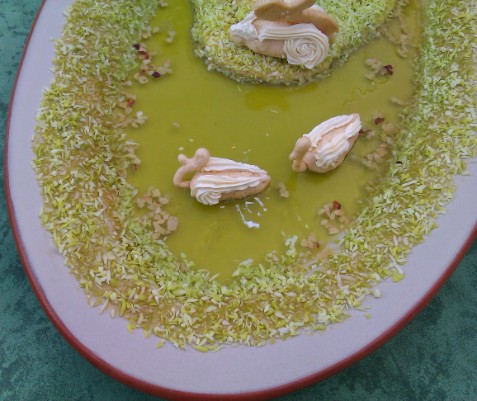
Pic 8 The top swan has a broken neck. Meringue is more difficult to work with than choux paste (ie for eclairs). In both cases, there is a
swan "profile" consideration. Consider the flat surface of the swan's neck compared with the more normal profile in Pic 6. Return to
Pic 1. Did you notice that it is a flat-profile swan and wonder how it felt about it.?
The rear cygnet has frightened the other one which left cream on the jelly. Start again.
Tchaikovsky
in book
Dr. Seuss knew this; that’s why he conceived the Grinch’s nefarious plan to steal Christmas as involving the theft of Whoville’s canned goods, roast beast, etc. Charles Dickens knew this; that’s why he directed his reformed Ebenezer Scrooge to have a big turkey delivered to his impoverished employee’s home. Peter Ilyich Tchaikovsky knew this; that’s why he composed a whole ballet revolving around dancing candy and a prince enchanted to crack nuts between his wooden teeth. source nutcracker